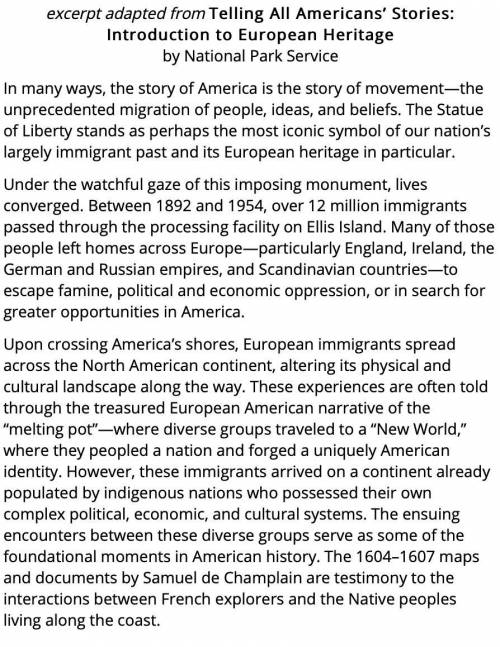clarissajimenez27
02.12.2020 •
English
Excerpt adapted from Telling All Americans’ Stories: Introduction to European Heritage
by National Park Service
In many ways, the story of America is the story of movement—the unprecedented migration of people, ideas, and beliefs. The Statue of Liberty stands as perhaps the most iconic symbol of our nation’s largely immigrant past and its European heritage in particular.
Under the watchful gaze of this imposing monument, lives converged. Between 1892 and 1954, over 12 million immigrants passed through the processing facility on Ellis Island. Many of those people left homes across Europe—particularly England, Ireland, the German and Russian empires, and Scandinavian countries—to escape famine, political and economic oppression, or in search for greater opportunities in America.
Upon crossing America’s shores, European immigrants spread across the North American continent, altering its physical and cultural landscape along the way. These experiences are often told through the treasured European American narrative of the “melting pot”—where diverse groups traveled to a “New World,” where they peopled a nation and forged a uniquely American identity. However, these immigrants arrived on a continent already populated by indigenous nations who possessed their own complex political, economic, and cultural systems. The ensuing encounters between these diverse groups serve as some of the foundational moments in American history. The 1604–1607 maps and documents by Samuel de Champlain are testimony to the interactions between French explorers and the Native peoples living along the coast.
1
Drag each tile to the correct box. Not all tiles will be used.
What is the best way to organize the sentences to express how the author develops a central idea in the passage?
A central idea in the text is that many of the people
migrating to America were European immigrants.
The author describes how people came from “England,
Ireland, the German and Russian empires, and
Scandinavian countries—to escape famine, political
and economic oppression, or in search for greater
opportunities in America.”
This detail shapes the idea because it lists European
countries that the people came from and
explains several reasons why they left for America.


Solved
Show answers
More tips
- F Food and Cooking What age is appropriate for giving your child cocoa?...
- A Auto and Moto How to Start a Diesel Engine in Cold Weather?...
- F Family and Home How to Remove Tar Stains: Tips and Recommendations from Experts...
- F Family and Home How to Remove Fading from Clothes: Tips and Tricks...
- S Sport How to Do a Jumping Split...
- H Health and Medicine How Did Inna Lose Weight on Dom 2?...
- F Family and Home How to Properly Fold Napkins in a Napkin Holder?...
- F Food and Cooking How to Set Up Ventrilo - The Ultimate Guide...
- S Science and Technology How to Make a Homemade Smoker: The Ultimate Guide...
- A Auto and Moto Battle for the Relocation of The Cherkizovsky Market: Who Won?...
Answers on questions: English
- E English The rise of zeus which statement best summarizes this passage? zeus defeated the titans and trapped them underground in mount othrys. the titans gave birth to zeus and...
- E English Hacemos esto cuándo obtienes una conclusión después de observar...
- E English Round 287301 to the nearest hundred thousand...
- E English Occasionally, shakespeare will insert himself into his plays. which moment in hamlet best reflects this? hamlet’s scene with the skull claudius’s confession hamlet’s advice...
- E English HELP ME PLZ What made the Jews decide to take back Israel?...
- E English 100 Points!! Have A great Day And... Select all that apply. What are the three main elements of exposition? characters the narrator place textual evidence time...
- E English The main idea of this reading is that Scrabble players will be most happy with certain kinds of additions to the official Scrabble dictionary. Which selection below is...
- E English Please i’m begging y’all to help me, the questions are in the picture and the passage is down below. The Three Brothers was soon under way, leaving the calm waters of the...
- E English Cathy is writing a script for a presentation about the French Revolution. Which of the following sentences would be most appropriate for the body of her presentation? Group...
- E English A two column table with five rows. The first column, x, has the entries, 0, 1, 2, 3. The second column, y, has the entries, 1, 2, 4, 8. A two column table with five rows....

Ответ:
The author describes how people came from “England, Ireland, the German and Russian empires, and Scandinavian countries—to escape famine, political and economic oppression, or in search for greater opportunities in America.”
This detail shapes the idea because it lists European countries that the people came from and explains several reasons why they left for America.
Explanation:
The above is the best way to organize the sentences to express how the author develops a central idea in the passage.
This is correct because it stated a line from the excerpt that points to the central idea. It was from this line that the idea of the passage can be seen. Also, this line of detail contributes to shaping the idea. Therefore, the above arrangement is correct.
Ответ: